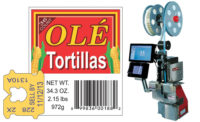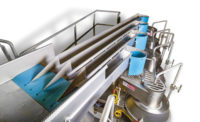Growing consumer demand for better-for-you, gluten-free and innovative baked goods and snacks continues to drive bakers and snack manufacturers to explore new ingredients and formulations. It’s also prompting them to re-examine their equipment needs, as they discover that their existing machinery may not be able to efficiently handle today’s in-demand products. For some manufacturers, a new extruder may be just the ticket.
Technological flexibility
“Twin-screw extrusion technology is very flexible and well-suited for the development of better-for-you products,” says Mike Shaw, sales account manager for extruded products, Bühler Group, Minneapolis. “A large variety of healthy ingredients can be used to produce products that are high in protein, gluten-free or made with multi-grains containing fiber and nutrients.”
Shaw adds that “various parameters in the twin-screw extruder can be dialed in to obtain the desired product attributes to compensate for some of the challenges in running these base materials. Different forms are possible, as well.” Forms include both expanded products and non-expanded cracker- or chip-like products.
“The main strength of extrusion is its versatility,” says Keith Graham, marketing manager, Baker Perkins Ltd., Peterborough, England. “An extruder can be configured to make any of a wide range of different snacks, including standard direct-expanded curls, balls, rings and chip sticks; texturally diverse cracker snacks; croutons and crispbreads; and added-value, co-extruded snacks, bars and wafers.”
Graham agrees that extrusion is “an excellent process” for developing snacks with ingredients that add interest, variety or an enhanced nutritional profile. “Extruded snacks can use flour from whole-grain and multigrain sources, as well as from vegetables or legumes,” he adds, “and can have functional ingredients, such as added protein or fiber. Gluten-free is also easily achieved.”
Baker Perkins’ most-recent addition to its twin-screw extrusion line is a process for making cracker-type snacks. A new die produces a thin, wide sheet of dough, which is cut into regular, geometric shapes by an inline rotary cutter. The shapes can be fried as a conventional snack or oven-baked for a lower fat content, and then flavored. “Using extruders to make sheeted snacks taps into a trend for thinner snacks with plenty of crunch, but less product and, hence, fewer calories,” Graham says. Another version of this process extrudes profiled dough ribbons cut into short lengths. The profile can be rippled, curved or have V-shaped channel effects.
Other additions to Baker Perkins’ co-extrusion equipment line are a 16-stream die and twin-filling dies. “The new 16-stream die increases the maximum capacity that can be attained with this technology, while the twin-filling dies make possible the production of bars with two separate fillings,” explains Graham. “These products can be marketed as bar-sized premium snacks with contrasting or complementary fillings, such as chile and salsa or chocolate and orange cream.”
Moline Machinery LLC, Duluth, MN, offers a wide variety of sheeting systems and dough extruders, says David Moline, sales and marketing manager. “The first stage within a sheeting system is a dough extruder,” he explains. “It accepts the dough from the mixing system and produces a continuous sheet or ribbon of dough. The sheeter reduces it to its final thickness.
“Extrusion is what really provides versatility to a sheeting system,” Moline continues. “You can change the extruder and go from making a tight-grained product to a very open-grained, ancient grain, artisan product all on the same system.” Current consumer favorites like tortillas, thin crackers and flatbreads can all be made with an extruder.
Moline Machinery’s RAM pump feeder, which it acquired last summer from Ram Equipment Co., Waukesha, WI, is designed to transport and dispense high-viscosity materials, such as butter and fillings. However, it can also be used for dough extrusion, says Moline. “It’s going to be limited to applications where you want to maintain a very tight grain structure,” he adds. “This would be products like tortillas, flatbreads, low-hydration doughs and drier, high-fiber doughs.”
Ingredient considerations
While today’s extrusion technology is ready to meet bakers’ and snack manufacturers’ production needs, some of the healthier ingredients currently popular among consumers may require some additional preparation beforehand.
“The extruded snack category continues to evolve to meet consumer trends toward healthier product alternatives,” says Doug Baldwin, vice president, food & industrial products division, Wenger Manufacturing Inc., Sabetha, KS. “While the modern twin-screw extruder provides a wide window of operating parameters, new and unique ingredients will benefit from a preconditioning step prior to extrusion.”
Baldwin explains that while preconditioners typically have been available only as an integral part of the extrusion process, Wenger has introduced a preconditioner configuration mounted on a rail system that allows users to bypass this step for basic, single-ingredient snacks, or to move the preconditioner into place when making a product with more-complex ingredient mixes.
The preconditioner can be used to make extruded snacks containing blends of healthier ingredient alternatives, such beans, peas, quinoa, sorghum and other ancient grains, that don’t expand as easily as corn, says Baldwin. “Simply controlling the particle size of these ingredients is not enough to allow them to be uniformly processed via the traditional single- or twin-screw snack extruder,” he notes. “The addition of a preconditioner provides a combination of aggressive mixing and residence time, which allows the water to be adequately absorbed into the dry blend.”
Shaw notes that manufacturers may also encounter variances in raw materials throughout the year due to seasonal fluctuations and different vendors. “Twin-screw extruders can be adjusted to compensate for these variations to obtain the same targeted finished product,” he says. “In addition, oftentimes, more-economical raw materials can be used to cut costs, while still maintaining the product target.”
Bakers and snack manufacturers creating new extruded products or changing an existing formulation might find a test beneficial before investing in new equipment. “The importance of proving new products before they are launched is crucial,” says Graham. “This is why Baker Perkins has recently installed a twin-screw extruder in its Innovation Center in Grand Rapids, MI. It enables companies in the snack and other extruded food sectors to create new products and processes, produce samples for evaluation, carry out feasibility studies and train staff.
Extrusion opportunities
Numerous consumer eating trends are sure to make some bakers and snack producers consider investing in their first or a new extrusion system.
“The trend to ‘food on the move’ continues to grow,” says Graham. “Extruded snacks are an ideal part of a healthy, balanced meal replacement.”
Graham notes that extruded snacks are also ideal carriers for the ethnic and regional flavors that appeal to a wider range of consumers today. “Asian, Middle Eastern and Hispanic tastes are increasingly popular,” he says. “Chile, paprika, teriyaki, guacamole, sweet-and-sour, black bean sauce and a wide family of curries can be used individually or in combination to produce snacks with high-consumer appeal.”
In addition, healthier ingredients from a wide range of sources, including grains, vegetables, legumes and fruit, and textures varying from light and crispy to hard and crunchy, all offer product-development opportunities, Graham adds.
“Increased consumer awareness of unique and specialty ingredients have spurred baked goods and snack producers to investigate these raw materials and ways of expanding their product offerings,” says Shaw.
Consumer demand for baked goods and snacks featuring healthy ingredients, on-trend flavors, interesting textures and more will continue to drive bakers and snack producers to develop products that deliver—and many of these goods will emanate from extrusion systems.








